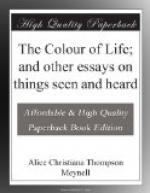The great hood of the friars, which is drawn over the head in Zurbaran’s ecstatic picture, is turned to use when the friars are busy. As a pocket it relieves the over-burdened hands. A bottle of the local white wine made by the brotherhood at Genoa, and sent to this house by the West, is carried in the cowl as a present to the stranger at the gates. The friars tell how a brother resolved, at Shrovetide, to make pancakes, and not only to make, but also to toss them. Those who chanced to be in the room stood prudently aside, and the brother tossed boldly. But that was the last that was seen of his handiwork. Victor Hugo sings in La Legende des Siecles of disappearance as the thing which no creature is able to achieve: here the impossibility seemed to be accomplished by quite an ordinary and a simple pancake. It was clean gone, and there was an end of it. Nor could any explanation of this ceasing of a pancake from the midst of the visible world be so much as divined by the spectators. It was only when the brother, in church, knelt down to meditate and drew his cowl about his head that the accident was explained.
Every midnight the sweet contralto bells call the community, who get up gaily to this difficult service. Of all duties this one never grows easy or familiar, and therefore never habitual. It is something to have found but one act aloof from habit. It is not merely that the friars overcome the habit of sleep. The subtler point is that they can never acquire the habit of sacrificing sleep. What art, what literature, or what life but would gain a secret security by such a point of perpetual freshness and perpetual initiative? It is not possible to get up at midnight without a will that is new night by night. So should the writer’s work be done, and, with an intention perpetually unique, the poet’s.
The contralto bells have taught these Western hills the “Angelus” of the French fields, and the hour of night—l’ora di notte—which rings with so melancholy a note from the village belfries on the Adriatic littoral, when the latest light is passing. It is the prayer for the dead: “Out of the depths have I cried unto Thee, O Lord.”




